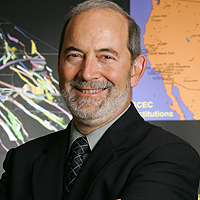Do you feel lucky, California?
The odds of avoiding a major quake in the next 30 years are about the same as flipping a coin and having it come up heads six times straight: almost nil, according to a new study.
The study, released April 14 in simultaneous news conferences at USC and in the San Francisco Bay area, finds a greater than 99 percent chance that a quake as big or bigger than the 1994 Northridge will hit somewhere in California by 2037.
But it could happen a lot sooner, according to the study. The chance of a big quake within five years is 50-50. The 10-year probability is about 75 percent.
The 30-year probability of an even more damaging, magnitude 7.5 quake - nearly 30 times stronger than Northridge - is almost 50 percent, USC University Professor Thomas Jordan said at the news conference.

|
| ©Philip Channing |
| The study's authors include University Professor Thomas Jordan. |
Jordan directs the Southern California Earthquake Center, which prepared the study in collaboration with the U.S. Geological Survey and the California Geologic Survey.
"Our study is significant because it presents for the first time a comprehensive earthquake forecast for the entire state," Jordan said.
As such, the study will permit meaningful comparisons between regions and is expected to influence building codes, insurance rates, loss estimates and emergency and community preparedness efforts.
Southern California has a two-in-three chance of experiencing at least a Northridge-sized earthquake in the next 30 years. The likelihood of such a quake on the southern San Andreas fault is about 60 percent, according to the study.
The study's authors, which included Jordan and representatives of the U.S. Geological Survey and California Geologic Survey, based their forecasts on past earthquake data, geological evidence, computer simulations, fault maps and opinions from other leading seismologists affiliated with the Southern California Earthquake Center, a 62-institution consortium based at USC.
The findings largely confirm those of earlier, regional forecasts released in 1995 and 2002.
The authors hope to mitigate the human and financial cost of the next big earthquake. The Northridge quake killed 57, injured thousands and caused billions in property damage. Even though several commercial buildings and highway overpasses collapsed, casualties were relatively low because the quake hit in the early morning hours of a federal holiday (Martin Luther King Day).



Reader Comments
to our Newsletter